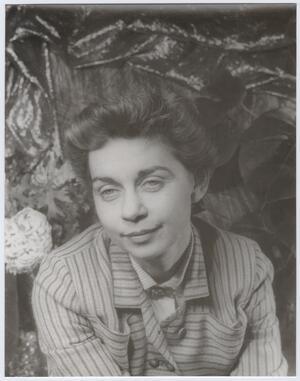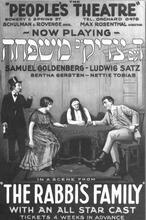Jean Rosenthal
Jean Rosenthal was a pioneer in theater lighting design, finding new aesthetics for dance performances and theater productions. Rosenthal studied at the Neighborhood Playhouse School and became enamored of the famed faculty member Martha Graham. She helped out with various aspects of production and technical work for Graham’s performances, then enrolled at Yale to gain more technical training. In 1938 she became a production assistant at Orson Welles’s Mercury Theater. She composed lighting for major Broadway plays including 1957’s West Side Story, 1960’s Becket, 1964’s Fiddler on the Roof, 1965’s The Odd Couple, and 1966’s Cabaret. She founded her own mail-order catalog company in 1940. She continued working with Graham throughout her career until her death, calling their collaborations a renewal of her interior spirit.
Jean Rosenthal was a pioneer in theater lighting design. “Light is quite tactile to me. It has shape and dimension.” Inspired by the paintings of Rembrandt and Monet, Rosenthal mastered the technical and poetic aspects of stage lighting. She used light’s form, color, and movement to express the intention of performance. Carefully integrating light into the overall texture of a piece, Rosenthal believed that “the most successful and brilliant work a lighting designer can do is usually the least noticeable.”
Early Life and Family
Born Eugenie Rosenthal in New York City, on March 16, 1912, she was the only daughter and second of three children of Pauline (Scharfman) and Morris Rosenthal. Her parents, who emigrated from Romania in the 1880s, were both children of Jewish tailors. An unconventional family for the time, both parents worked as medical doctors, her father as an ear, nose, and throat specialist, her mother as a psychiatrist.
Following her mother’s progressive educational beliefs, Jean and her brothers attended the Ethical Culture School in the Bronx and later enrolled in the experimental Manumit School in Pawling, New York. With good humor, Rosenthal described the unorthodox yet holistic education she received at Manumit: “We... learned how to enter a chicken coop without scaring the chickens. Very valuable thing to know when you work in the theatre.” For high school, Rosenthal studied at the Friends Seminary in Manhattan, a more formal educational environment, where she had a difficult time fitting in. At age sixteen, Rosenthal barely graduated from the school.
Education and Early Career
With her grades too low for her to be accepted at a prestigious college, Rosenthal enrolled in the Neighborhood Playhouse School of the Theatre in Manhattan. She was soon captivated by the experimental dance work of one faculty member, Martha Graham. Between 1928 and 1930, Rosenthal immersed herself in Graham’s work, doing all aspects of production and technical assistance. In order to get more rigorous technical training, Rosenthal enrolled in the Yale University School of Drama from 1931 to 1934. There, she studied closely with the well-known stage lighting instructor Stanley McCandless. In 1932, Rosenthal received the Henrietta Lord Memorial Award for her work at Yale.
Rosenthal’s first professional job was in 1935 as production supervisor for a WPA theater project in New York City. In this setting, she worked with John Houseman and Orson Welles and, in 1937, became a production assistant for Welles’s Mercury Theatre. During Welles’s production of Julius Caesar in 1937, Rosenthal made a name for herself as an inventive lighting designer, bringing her a succession of jobs on Broadway. To supplement this production work, Rosenthal founded her own company in 1940, the Theatre Production Service, which ran a mail-order catalog for theatrical equipment.
Career Successes
Rosenthal did the stage lighting for a number of well-known Broadway plays and musicals, such as West Side Story (1957), Becket (1960), Hello, Dolly! (1964), Hamlet (1964), Fiddler on the Roof (1964), The Odd Couple (1965), and Cabaret (1966). She is most famous for her unconventional lighting of dance and opera performances, including long-term collaborations with Gian Carlo Menotti, the New York City Ballet and its predecessor the Ballet Society, Martha Graham, and the New York City Opera. Rosenthal also worked as an illumination, theater, and restoration consultant, assisting on such projects as the Pan-American terminal at the John F. Kennedy Airport in New York, the Los Angeles Music Center, the American Shakespeare Festival Theater in Connecticut, as well as theaters in Canada and Australia.
A small, dark-haired woman with large blue eyes, Rosenthal confronted the sexism of her male-dominated profession by being very courteous, commonly referring to her crew of electricians as “darling” and “honey.” She spent her free time in the company of close friends, disliking the more formal social life of cocktail parties. A lifelong New Yorker, Rosenthal shared her apartment, as well as her home on Martha’s Vineyard, with artist Marion Kinsella.
Throughout her career, Rosenthal favored dance performances, particularly the abstract works of Martha Graham. In contrast to Broadway musicals and plays, which required a relatively standardized lighting design, Graham’s dances allowed for imaginative and experimental illumination. Rosenthal used dramatic side lighting, giving dancers a sculptural quality. She made Graham’s performances a professional priority: “To do one or two new works for Martha a year was a part of my life and a renewal of my own interior spirit.” In the last weeks of her life, suffering from cancer and confined to a wheelchair, Rosenthal designed the lighting for her final Graham piece. Until her death in New York City, on May l, 1969, Rosenthal lived a “lifetime in light.”
Billy Rose Theatre Collection. New York Public Library.
Harbin, Billy J., Kim Marry, and Robert A. Schanke. The Gay & Lesbian Theatrical Legacy: A Biographical Dictionary of Major Figures in American Stage History in the Pre-Stonewall Era. Ann Arbor, MI: University of Michigan Press, 2005.
Lael Wertenbaker Collection. Mugar Library, Boston University.
Marra, Kim and Robert A. Schanke, eds. Staging Desire: Queer Readings of American Theater History. Ann Arbor, MI: University of Michigan Press, 2002.
NAW modern.
Obituary. NYTimes, May 2, 1969, 43:1.
Ridgon, Walter, ed. Biographical Encyclopaedia and Who’s Who of American Theatre. New York: J.H. Heineman Inc., 1966.
Rosenthal, Jean. Papers. Wisconsin Center for Film and Theater Research, University of Wisconsin, Madison; Rosenthal, Jean, and Lael Wertenbaker.
Rosenthal, Jean. The Magic of Light: The Career and Craft of Jean Rosenthal, Pioneer in Lighting for the Modern Stage Boston, MA: Little, Brown and Company, 1972.
Sargeant, Winthrop. “Please, Darling, Bring Three to Seven.” The New Yorker (February 4, 1956): 33–59; WWWIA 5.




